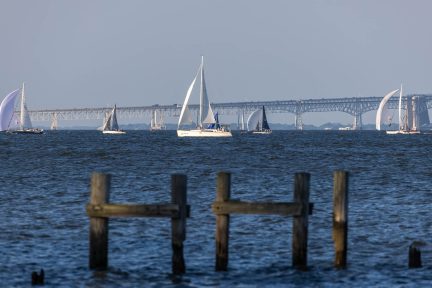Chesapeake Bay water quality inches toward a new record
Chesapeake Bay water quality inches toward a new record
The Chesapeake Bay Program announced today that water quality in the Chesapeake Bay met its highest standard for water quality since monitoring began in 1985, besting its previous record reported in 2017. According to preliminary data, an estimated 42 percent of the Chesapeake Bay and its tidal tributaries met clean water standards for clarity (measured by observing underwater grass abundance), dissolved oxygen, and chlorophyll-a between 2015 and 2017. This five percent increase from the previous assessment period is due in large part to reductions in chlorophyll-a (a measure of algae growth) and increases in underwater grass abundance and dissolved oxygen in the open waters of the Bay.
New research conducted by Chesapeake Bay Program experts, and published in Science of the Total Environment, described the “positive and statistically significant trends” observed in the water quality of the Bay—an important indicator of environmental health. This suggests that the water quality of the Bay is improving due to the decades-long effort to reduce nutrient pollution and is more resilient to the impacts of extreme weather (such as Hurricane Irene and Tropical Storm Lee). However, water quality remains far below 100 percent attainment, with 58 percent of tidal waters still considered impaired.
Water quality is influenced by nutrient and sediment loads from the watershed and vary each year due to land use and river flow. Between October 2016 and September 2017, river flow to the Bay measured a below-average of 47.7 billion gallons per day. During this same period, approximately 240 million pounds of nitrogen, 12.7 million pounds of phosphorus and 4.3 billion pounds of sediment reached the Bay: a 0.4 percent, seven percent and 14 percent decrease from the previous assessment period, respectively.
While the amount of nitrogen, phosphorus and sediment entering the Bay from the watershed can change dramatically from year to year, the fact that nutrient and sediment loads decreased between 2016 and 2017 even as river flow increased could be a positive sign toward controlling pollution. However, the impacts from the record amounts of rainfall across the entire watershed in 2018 are still being realized and will be reflected in the data being collected now. These weather patterns not only contributed to high river flows and heavy flooding, but also brought a larger amount of fresh water into the Bay, leading to fewer jellyfish, a lingering “dead zone” and finfish moving to new areas. It remains to be seen how this will impact the water quality of the Bay in the future.
Monitoring data collected from River Input Monitoring stations on the nine major rivers in the Chesapeake Bay watershed provide long-term trends for nitrogen, phosphorus and sediment entering the Bay and its tidal tributaries. A recent U.S. Geological Survey (USGS) analysis of long-term trends (1985-2017) in pollution loads found that nitrogen loads improved at the majority of the stations. However, long-term trends in phosphorus loads indicate improving conditions at only three stations and degrading conditions at another five, while long-term trends in sediment loads show improving conditions at three stations and degrading conditions at two.
In early April, the Chesapeake Bay Program will release the 2017-18 Bay Barometer: Health and Restoration in the Chesapeake Bay Watershed, which will further explain how the entire Chesapeake Bay ecosystem and its watershed are responding to the partnership’s collective protection and restoration efforts.
Facts
New research published in the Science for the Total Environment shows a significant, upward trend in the estimated water quality standards attainment status from 1985-2016 (Note: Released in 2018, the study considered data through 2016) When compared with long-term average conditions in 1985-2016, water quality standards in the Chesapeake Bay improved considerably in the previous assessment period of 2014-2016. This is largely driven by an improvement in dissolved oxygen conditions in the deep and open waters of the Bay, as well as a growth in underwater grass abundance.
Additionally, these findings show that management actions taken by Chesapeake Bay Program partners to address nutrient and sediment pollution entering the Bay are contributing to its recovery, indicating that the Chesapeake Bay Total Maximum Daily Load (TMDL) is working. Chesapeake Bay Program researchers reached a similar conclusion last spring when an article published in the Proceedings of the National Academy of Sciences linked the increase of underwater grasses to actions taken under the Bay TMDL. Local efforts to reduce nutrient and sediment pollution have shown some success under the Bay TMDL, but the challenge of putting enough conservation practices on the ground to further reduce agricultural and urban runoff to local waterways remains.
The USGS works with state partners to monitor nitrogen, phosphorus and sediment loads entering the Chesapeake Bay from nine River Input Monitoring stations, which together reflect the nutrient and sediment loads delivered to the Bay from approximately 78 percent of its watershed. To estimate pollution loads delivered from the remaining 22 percent of the watershed, the Chesapeake Bay Program partnership pairs this data with nutrient levels in water samples collected at wastewater treatment plants, computer-simulated estimates of nutrient loads from nonpoint pollution sources and computer-simulated estimates of the atmospheric deposition of nitrogen to tidal waters. The USGS also determines long-term and short-term trends in nutrient and sediment loads and works with the U.S. Environmental Protection Agency (EPA) and state partners to collect monitoring data at more than 100 non-tidal monitoring stations to assess the aquatic response to efforts to reduce agricultural and urban runoff.
These pollution load estimates, which are derived from land use and best management practice implementation, are just one in a suite of tools the EPA uses to evaluate whether jurisdictions are on track to meet the Bay TMDL and its two-year milestone commitments. The EPA also considers data and information on best management practice implementation, best management practice effectiveness and jurisdictions’ progress toward putting programs in place to achieve pollution cuts.
Issues
Excess nutrients and sediment are among the leading causes of the Bay’s poor health. Nitrogen and phosphorus can fuel the growth of algae blooms that lead to low-oxygen “dead zones” in deep waters and short-duration “mortality moments” in shallow waters.
Sediment can block sunlight from reaching underwater grasses and suffocate and bury shellfish. Pollution-reducing practices used in backyards, in cities and on farms can reduce the flow of nitrogen, phosphorus and sediment into waterways. Management actions taken to decrease loads from point sources (e.g., wastewater treatment plants) may immediately show detectable pollution changes, but in regard to the implementation of conservation practices for non-point sources, there is often a lag in measuring their impact on improving water quality and the health of the Bay.
Quotes
“It is very promising to see the Bay achieve its highest water quality scores two years in a row! Improvements in water quality take time, but we are finally seeing a positive response to the many restoration efforts of our partners. This research is also showing more evidence of the Bay’s resiliency, which has increased as a direct result of all the pollution reductions achieved to date. We must continue the good work! While we have made a lot of progress, there still a lot more work to do to achieve that 100 percent water quality attainment.”
- Dinorah Dalmasy, Co-Chair, Chesapeake Bay Program Water Quality Goal Implementation Team and Program Manager, Maryland Department of the Environment
“Everyone who contributed to the new research published in the Science of the Total Environment were excited to find that the Chesapeake Bay achieved its highest score in water quality standards attainment since 1985, and that its long-term improvement was closely linked to the reduction of nitrogen loads from the watershed. This presents further evidence that the management efforts to restore the Chesapeake Bay are working.”
- Dr. Qian Zhang, Watershed Effectiveness Data Analyst, Chesapeake Bay Program and Assistant Research Scientist, University of Maryland Center for Environmental Science
“The hard work of more than 1,800 local governments across the Chesapeake Bay watershed is paying off as water quality in the Bay, and in our local streams, is showing significant progress. Despite changing requirements, continued collaboration and cooperation between Bay partners is critical to meeting the goal of restoring the magnificent and unique Chesapeake Bay. It’s exciting to celebrate our successes and surmount our challenges—together.”
- Penny Gross, Chesapeake Bay Program Local Government Advisory Committee and Fairfax County Board of Supervisors



